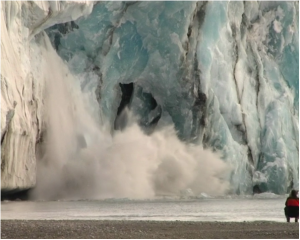Calving
Calving of a glacier is the process by which ice blocks break away from the front of a glacier, under the influence of gravity (if the glacier is above water and does not touch it) or buoyancy (if the front of the glacier is below the water surface).
Lumps of ice that calve off the front of the glacier can have very different sizes – from small slivers of ice to giant icebergs, which can have a surface area of up to hundreds of square kilometres. Solid ice that detaches from the front of a glacier located at the surface of the water float away as icebergs or growlers (sort of ice rubble).
The water on the front of a glacier causes the ice in the glacier to disintegrate into smaller parts. This disintegration simultaneously causes waves to form on the surface of the water. Such waves can pose a threat to vessels, if calving happens close by.
Calving is a very important factor in the normal retreat of glaciers as they flow towards the sea. The point at which a glacier is no longer lying on land but starts to float over the water is known as the grounding line.




 This project (EDU-ARCTIC) has received funding from the European Union’s Horizon 2020 research and innovation programme under grant agreement No 710240. The content of the website is the sole responsibility of the Consortium and it does not represent the opinion of the European Commission, and the Commission is not responsible for any use that might be made of information contained.
This project (EDU-ARCTIC) has received funding from the European Union’s Horizon 2020 research and innovation programme under grant agreement No 710240. The content of the website is the sole responsibility of the Consortium and it does not represent the opinion of the European Commission, and the Commission is not responsible for any use that might be made of information contained.